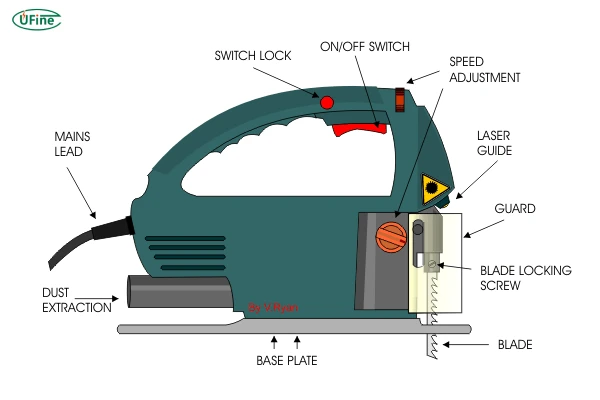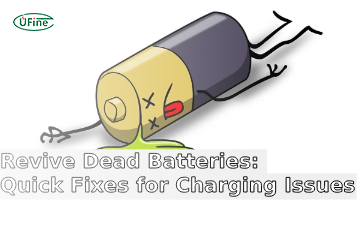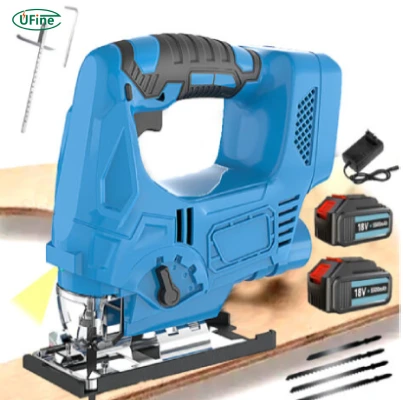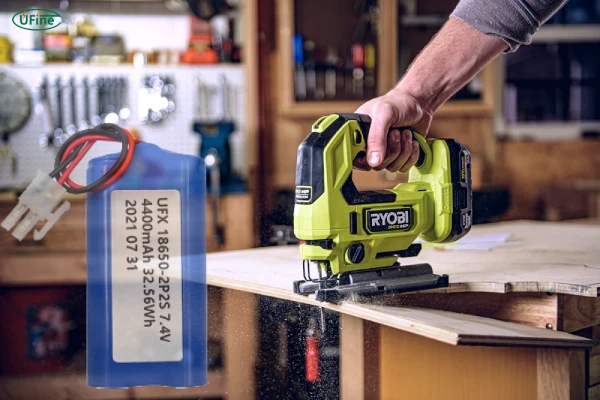
- Part 1. Learn jigsaw tool battery
- Part 2. How a jigsaw works
- Part 3. Key battery specs
- Part 4. Lithium-ion vs. NiMH vs. NiCd: What's best?
- Part 5. 18V vs. 20V jigsaw batteries
- Part 6. Power vs. runtime: what do you really need?
- Part 7. Can you mix and match jigsaw batteries across brands?
- Part 8. Tips to make your jigsaw battery last longer
- Part 9. When should you replace your jigsaw battery?
- Part 10. How to choose the best battery for your jigsaw
- Part 11. Where to buy quality jigsaw tool batteries
- Part 12. FAQs
A jigsaw is one of the most useful tools in any workshop. Whether you’re a pro carpenter or a DIY enthusiast, you’ve probably used one to make curved cuts, holes, or detailed shapes. But there’s one part of your jigsaw that often gets overlooked—the battery.
If you’re using a cordless jigsaw, the battery is the heart of your tool. Without the right battery, your tool could cut slower, run out of power fast, or even stop working mid-project. That’s frustrating—and unnecessary.
In this guide, we’ll break down everything you need to know about jigsaw tool batteries. You’ll learn how they work, how to choose the right one, and how to make them last longer.
Part 1. Learn jigsaw tool battery
Jigsaws need a steady power supply to drive the motor and keep the blade moving smoothly. A weak battery can make the motor stutter. You might even feel your tool slowing down in the middle of a cut. Worse, your blade could bind or overheat.
With a strong battery, on the other hand, you get smooth, powerful performance. You can cut wood, metal, or plastic with ease. That’s why choosing the right battery isn’t just about convenience—it’s about safety, quality, and getting the job done right.
Part 2. How a jigsaw works

In a cordless jigsaw, electricity from the battery powers a motor. That motor moves the blade up and down quickly—often thousands of strokes per minute. The smoother and more consistent the power, the cleaner your cuts.
If your battery can’t deliver enough current, the motor struggles. The blade slows down, and your cuts become rough or uneven. That’s why the jigsaw tool battery needs to be strong, stable, and reliable.
Part 3. Key battery specs
When you’re shopping for a battery, don’t just grab the one that fits. You need to check the specifications. Here are the most important ones:
- Voltage (V): More volts = more power. Most jigsaws use 18V or 20V batteries.
- Capacity (Ah): Stands for amp-hours. Higher Ah means longer runtime.
- Watt-hours (Wh): Power over time. It’s calculated by voltage × amp-hours.
- Battery chemistry: Lithium-ion is the most common. We’ll explain more in a bit.
- Discharge rate (C-rate): Determines how fast the battery can deliver power.
These numbers matter. A battery with low capacity or poor discharge can leave you stranded halfway through a cut.
Part 4. Lithium-ion vs. NiMH vs. NiCd: What’s best?
There are a few types of batteries used in power tools. Here’s how they compare:
- Lithium-ion (Li-ion):
- Most modern cordless jigsaws use these.
- Lightweight, long life, and fast charging.
- No memory effect.
- More expensive, but worth it.
- Nickel-Metal Hydride (NiMH):
- Older technology.
- Heavier and less efficient.
- Can self-discharge quickly.
- Nickel-Cadmium (NiCd):
- Rare today due to toxicity and memory issues.
- Heavy and outdated.
So if you’re buying new, go with lithium-ion. It’s the safest and most efficient choice.
Ufine Battery specializes in high-performance lithium-ion batteries, including 18650 cells, custom battery packs, and power tool-specific batteries. Our batteries are perfect for jigsaws that need reliable, high-discharge energy. Get a quote or start your project
Part 5. 18V vs. 20V jigsaw batteries
You’ve probably seen tools marketed as 18V or 20V. But here’s a little secret: they’re often the same thing.
- 18V is the nominal voltage (what the battery runs at).
- 20V is the maximum voltage (right after a full charge).
It’s mostly a marketing difference. So don’t worry too much—just make sure your battery matches your tool’s system.
Part 6. Power vs. runtime: what do you really need?
Some people want more power for cutting thick wood. Others care more about runtime for long projects.
- Higher voltage (V) = more cutting power.
- Higher amp-hours (Ah) = longer use before recharging.
If you’re cutting hard materials like hardwood or metal, go for power. For long sessions, pick a battery with a larger capacity.
Some pros even carry two batteries—one for power, one for runtime.
Part 7. Can you mix and match jigsaw batteries across brands?
Usually, no. Most jigsaw tool batteries are brand-specific. That means your Makita battery won’t fit a DeWalt jigsaw, and vice versa.
Each brand uses different shapes, sizes, and connectors. However, there are universal battery adapters and third-party brands that offer compatible models.
Be cautious, though. Some third-party batteries are lower quality or don’t match the tool’s requirements.
For manufacturers or custom tool brands, it’s smarter to work with a custom battery supplier like Ufine Battery. We’ll make sure the battery is designed to your tool’s specs, form factor, and discharge needs.
Part 8. Tips to make your jigsaw battery last longer
Want to avoid replacing your battery every few months? Here’s how:
- Charge with the right charger – Always use the original or a certified one.
- Don’t overcharge – Unplug once it’s full.
- Avoid full discharges – Try to recharge when it drops to around 20%.
- Store in a cool, dry place – Heat kills batteries.
- Use it regularly – Idle batteries lose charge over time.
Treat your battery well, and it’ll reward you with years of solid performance.
Part 9. When should you replace your jigsaw battery?
Batteries don’t last forever. Here are signs it’s time to replace yours:
- Rapidly losing charge
- Long charging time
- Overheating
- Bulging or strange smell
- Tool stutters or cuts weakly
If you notice these, it’s time for a new battery. And if you’re buying in bulk for your business or brand, consider working with Ufine Battery for customized, high-quality replacements.
Part 10. How to choose the best battery for your jigsaw
Here’s a quick checklist:
- Match the voltage to your tool.
- Choose lithium-ion for better performance.
- Pick the right Ah for your needs.
- Make sure it’s brand-compatible.
- Check for safety features like overcharge and short-circuit protection.
Want something truly tailored? Ufine Battery offers custom lithium battery solutions for jigsaws and other cordless tools. From voltage to size, we’ll build exactly what you need.
Part 11. Where to buy quality jigsaw tool batteries
You can buy replacement batteries from:
- Brand websites (DeWalt, Bosch, Makita)
- Hardware stores
- Online marketplaces (Amazon, Home Depot, etc.)
- Custom suppliers like Ufine Battery
Ufine Battery is a trusted Chinese lithium battery manufacturer. We offer custom solutions for power tools, including jigsaw tool batteries in all shapes, voltages, and sizes.
Whether you’re a tool brand, a distributor, or an OEM, we’ll design the perfect battery for your needs.
Part 12. FAQs
Can I use a higher Ah battery in my jigsaw?
Yes! It’ll last longer between charges. Just make sure the voltage matches.
Are aftermarket batteries safe?
Some are. But always check specs, reviews, and certifications.
How long do lithium jigsaw batteries last?
Typically 2–4 years with good care.
Can I repair a dead jigsaw battery?
It’s possible, but not recommended unless you’re experienced.
What’s better: multiple small batteries or one big one?
It depends. Small ones are lighter, but a big one gives longer runtime.
Related Tags:
More Articles

How to Revive Dead Batteries and Fix Lithium Batteries that Won’t Charge?
Learn how to safely revive a dead lithium-ion battery, troubleshoot charging issues, fix lithium battery problems, and extend battery life.
LiPo Battery Charge Rate Calculator
Calculate safe LiPo, Li-ion, and LiFePO4 battery charging times and rates. Prevent overcharging, extend life, and optimize performance.
4.0Ah vs. 2.0Ah Battery: Key Differences and Which is Best for Your Projects
Compare 2Ah vs 4Ah batteries: meaning, runtime, weight, and best tool uses. Learn if 4.0Ah is worth it for your cordless tools and DIY projects.
How Long do Lithium Batteries Last?
Learn how long lithium batteries last, their life expectancy, cycle life, and tips to extend lithium-ion battery lifespan effectively.
Lithium Battery Temperature Range: Everything You Need to Know
Learn optimal lithium battery temperature ranges for use and storage. Understand effects on performance, efficiency, lifespan, and safety.




